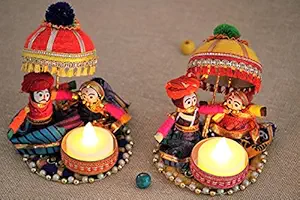પડવેથી પહેલુ માનું નોરતુ જી રે
એવા
બીજા તણા ઉપવાસ રે
માતા
આશાપુરા ગરબે રમે જી રે
ગરબે
રમે ને તાળી પડે જી રે
એવા
પડછડે ટહુકે ઝીણા મોર રે
માતા
આશાપુરા ગરબે રમે જી રે…
એવું
ત્રીજે થી ત્રીજું માંનુ નોરતુ જી રે
એવા
ચોથા તણા ઉપવાસ રે
માતા
આશાપુરા ગરબે રમે જી રે
ગરબે
રમે ને તાળી પડે જી રે
એવા
પડછડે ટહુકે ઝીણા મોર રે
માતા
આશાપુરા ગરબે રમે જી રે…
એવુ પાંચમે
થી પાંચમું માનું નોરતુ જી રે
એવા
છઠ્ઠા તણા ઉપવાસ રે
માતા
આશાપુરા ગરબે રમે જી રે
ગરબે
રમે ને તાળી પડે જી રે
એવા
પડછડે ટહુકે ઝીણા મોર રે
માતા
આશાપુરા ગરબે રમે જી રે…
એવું
સાતમે થી સાતમું માનું નોરતુ જી રે
એવા
આઠમાં તણા ઉપવાસ રે
માતા
આશાપુરા ગરબે રમે જી રે
ગરબે
રમે ને તાળી પડે જી રે
એવા
પડછડે ટહુકે ઝીણા મોર રે
માતા
આશપુરા ગરબે રમે જી રે…
એવું
નવમે થી નવમું માનું નોરતુ જી રે
એવો
દશેરાનો બોલો જય જયકાર રે
માતા
આશાપુરા ગરબે રમે જી રે
એવા
પડછડે ટહુકે ઝીણા મોર રે
માતા
આશાપુરા ગરબે રમે જી રે
પડવે થી
પેહલું માનું નોરતુ…
Overview of "Padve Thi Pelu Manu Noratu"
Title & Meaning
'Padve Thi Pelu Manu Noratu' is a traditional Gujarati Garba song performed during Navratri, celebrating devotion and cultural unity.
Artist & Recording Details
This Garba belongs to the folk repertoire, sung across Gujarat in community Garba nights; recorded by many regional artists.
Genre & Occasion
Devotional folk Garba, typically sung in Navratri and festive gatherings to honor Goddess Amba.
Language & Dialect
Lyrics are in Gujarati, reflecting local dialects and expressions tied to festival traditions.
Popularity & Versions
Well-known in villages and cities alike, the song has many live and recorded versions performed during Navratri.
Lyrics Structure & Themes
Devotional Invocation
The lyrics open with deep devotion, inviting Goddess Amba to bless the gathering.
Repetitive Chorus
Chorus lines repeated for rhythm and group participation, enhancing the dance experience.
Imagery & Symbolism
Symbols of festivity, colors, and rituals bring out the devotional and cultural depth of the song.
Community & Togetherness
Emphasizes collective celebration, faith, and unity in Navratri traditions.
Emotional Resonance
Lyrics evoke joy, devotion, and enthusiasm among devotees during Garba.
Musical & Performance Elements
Instrumentation & Rhythm
Traditional instruments like dhol, dholak, and claps provide energetic rhythm.
Tempo & Dynamics
Begins with a steady pace, building intensity for dancers as the night progresses.
Live vs Studio Renditions
Live Garba has extended verses with crowd interaction; studio versions are shorter and polished.
Dance Cues & Movements
Lyrics guide clapping, spins, and footwork in circular Garba formations.
Audience Participation
Encourages all devotees to sing along and dance, making it inclusive and engaging.
Festival & Cultural Significance
Navratri Connection
This Garba is a highlight of Navratri, invoking blessings and adding to the festive energy.
Spiritual Meaning
The song reflects devotion and surrender to Goddess Amba for protection and prosperity.
Preservation of Folk Culture
Represents the continuity of Gujarati folk culture, passed down through generations.
Community Bonding
Unites communities through shared singing, dancing, and worship.
Joyful Experience
Brings happiness, devotion, and cultural pride during the festival.
How to Use & Share
Translations & Transliteration
Providing translations helps non-Gujarati devotees connect with the song’s meaning.
Audio / Video Embeds
Embed live Garba performances and audio tracks to engage users more deeply.
Printable Lyrics & PDF Downloads
Offer lyrics in printable PDF format for personal or community use.
Performance Tips & Dance Guides
Provide basic dance steps, costume ideas, and timing tips for Garba performances.
SEO & Social Sharing Enhancements
Optimize with keywords like Garba, Navratri, Gujarati songs, Goddess Amba; add social sharing options.
'Padve Thi Pelu Manu Noratu' is a traditional Gujarati Garba song performed during Navratri, celebrating devotion and cultural unity.
This Garba belongs to the folk repertoire, sung across Gujarat in community Garba nights; recorded by many regional artists.
Devotional folk Garba, typically sung in Navratri and festive gatherings to honor Goddess Amba.
Lyrics are in Gujarati, reflecting local dialects and expressions tied to festival traditions.
Well-known in villages and cities alike, the song has many live and recorded versions performed during Navratri.
The lyrics open with deep devotion, inviting Goddess Amba to bless the gathering.
Chorus lines repeated for rhythm and group participation, enhancing the dance experience.
Symbols of festivity, colors, and rituals bring out the devotional and cultural depth of the song.
Emphasizes collective celebration, faith, and unity in Navratri traditions.
Lyrics evoke joy, devotion, and enthusiasm among devotees during Garba.
Traditional instruments like dhol, dholak, and claps provide energetic rhythm.
Begins with a steady pace, building intensity for dancers as the night progresses.
Live Garba has extended verses with crowd interaction; studio versions are shorter and polished.
Lyrics guide clapping, spins, and footwork in circular Garba formations.
Encourages all devotees to sing along and dance, making it inclusive and engaging.
This Garba is a highlight of Navratri, invoking blessings and adding to the festive energy.
The song reflects devotion and surrender to Goddess Amba for protection and prosperity.
Represents the continuity of Gujarati folk culture, passed down through generations.
Unites communities through shared singing, dancing, and worship.
Brings happiness, devotion, and cultural pride during the festival.
Providing translations helps non-Gujarati devotees connect with the song’s meaning.
Embed live Garba performances and audio tracks to engage users more deeply.
Offer lyrics in printable PDF format for personal or community use.
Provide basic dance steps, costume ideas, and timing tips for Garba performances.
Optimize with keywords like Garba, Navratri, Gujarati songs, Goddess Amba; add social sharing options.


